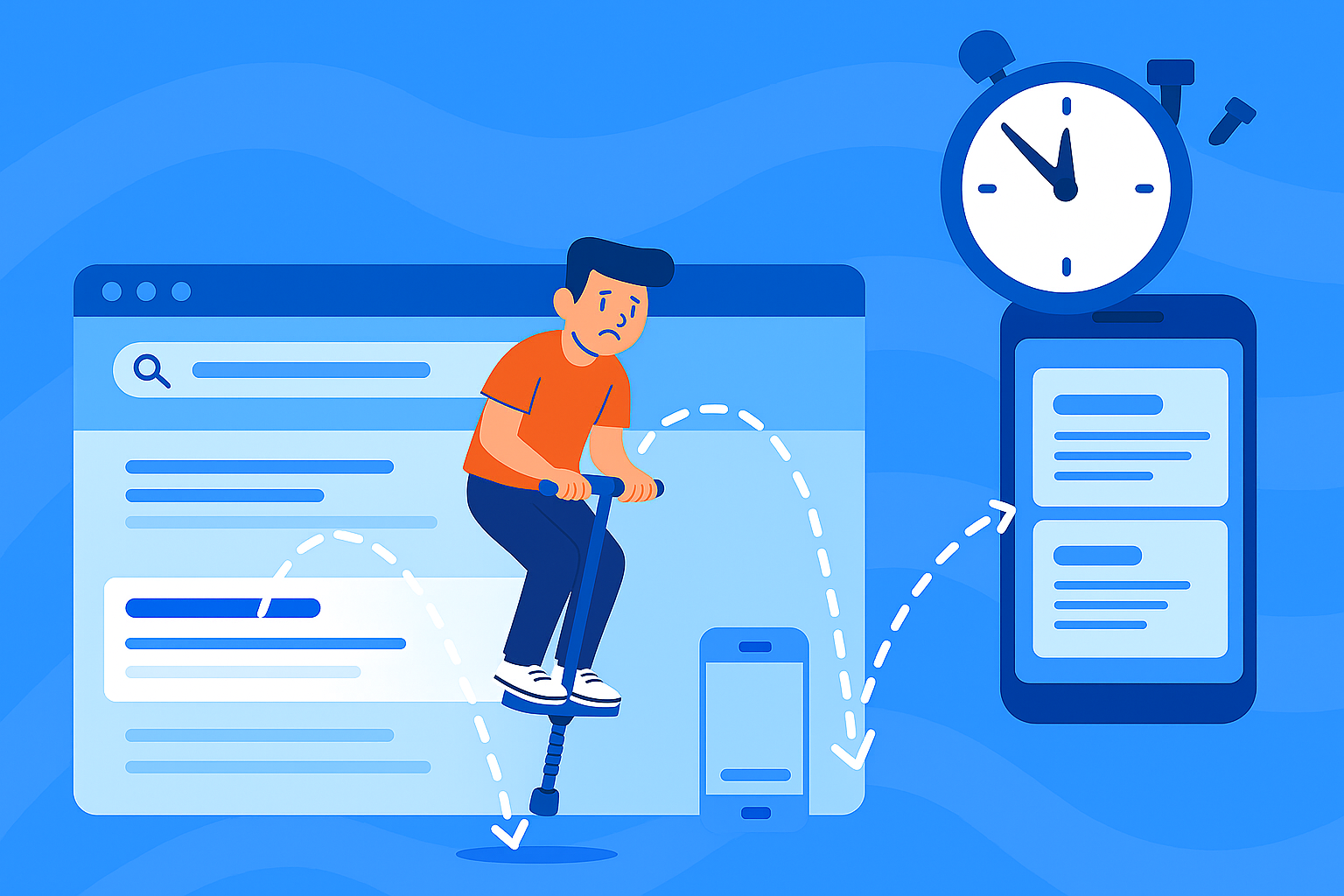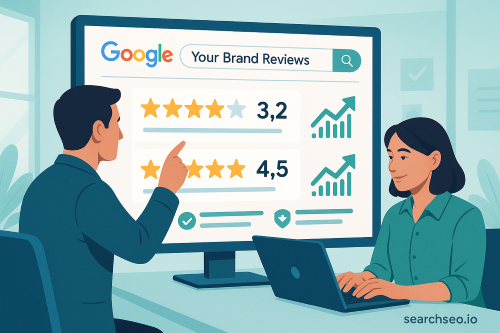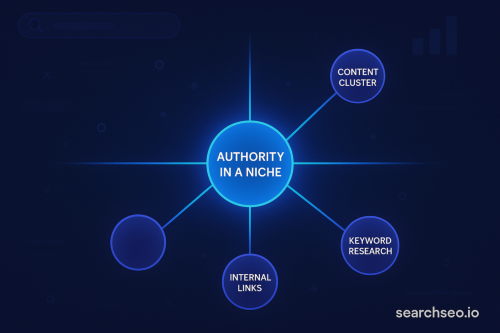Pogo sticking happens when someone clicks your page in Google’s search results, takes one quick look, then immediately bounces back to the search results to click something else.
In short, users “pogo” between results because what they found wasn’t helpful, relevant, or engaging enough.
It’s not just a bounce. It’s a clear sign that your page didn’t deliver what searchers expected when they clicked.

A simple example from Google search behavior
Imagine someone searches “best budget wireless headphones.”
They click a result promising “Top 10 Budget Headphones (2025 Update),” but when the page loads, it’s filled with outdated products or aggressive pop-ups. Within seconds, the user hits the back button and clicks the next link.
That’s pogo sticking in action, and it’s the kind of behavior Google doesn’t love to see.
Why SEOs and site owners should care
High pogo sticking rates often mean your content isn’t satisfying search intent. When that happens at scale, your rankings can slip because users are voting with their clicks. Even though Google says pogo sticking isn’t a direct ranking factor, it is a strong behavioral signal about user satisfaction, something Google’s algorithms are built to reward.
Pogo sticking vs bounce rate vs dwell time
Key differences between each metric
These three engagement metrics often get confused, but they measure very different things:
- Pogo sticking: user returns to search results immediately after clicking your page.
This shows the content failed to meet user expectations quickly. - Bounce rate: user leaves your site after viewing one page, even if they stayed for 5 minutes.
A bounce can still be positive if the user got what they needed. - Dwell time: how long a user spends on your page before going back to search results.
The longer the dwell time, the more likely your content satisfied intent.
Why bounce rate isn’t always bad
A high bounce rate isn’t automatically negative. If your blog post fully answers a question, like “How to check backlinks in Google Search Console,” a single-page visit can still be successful.
Pogo sticking, on the other hand, tells Google your page failed to meet expectations from the start.
How pogo sticking reflects poor search experience
When pogo sticking happens often, it signals a mismatch between what users search for and what your page delivers. It can point to poor UX, irrelevant content, or confusing structure, all red flags for engagement and SEO.
What causes pogo sticking?
Misleading or clickbait meta titles/descriptions
If your meta title promises one thing (“Ultimate SEO Audit Checklist”) but delivers something else (“Buy our SEO course!”), users will bounce fast. Always ensure your title and description match your content.
Users should always get exactly what your title and snippet promise.
Content mismatch with search intent
Even if your post ranks for a keyword, it can still miss the mark if it doesn’t align with the searcher’s intent (informational, commercial, or transactional).
Intent alignment ensures visitors immediately find the answer they expected.
Slow loading pages
Speed kills conversions and engagement. If your page takes more than 3 seconds to load, many users will leave before reading a single word.
Every extra second of load time increases the risk of pogo sticking.
Bad UX, popups, autoplay videos
Cluttered layouts, intrusive ads, or videos that start blasting audio can send visitors straight back to Google. UX matters as much as content quality.
A clean, calm, and predictable page design keeps users comfortable and engaged.
Thin, outdated, or unhelpful content
Pages with generic text, poor formatting, or outdated examples don’t hold attention. Searchers expect fresh, specific, and trustworthy insights.
Content that adds real value earns longer dwell time and repeat visits.
Is pogo sticking a ranking factor?
What Google has said publicly
Google has repeatedly said pogo sticking isn’t a direct ranking factor, but they do use user signals to assess search satisfaction.
In other words, pogo sticking doesn’t trigger penalties but still matters for user experience.
Why it likely isn’t direct but might influence indirectly
When users pogo-stick often, Google may interpret your page as less relevant to that query, which can lead to lower engagement metrics and eventual ranking drops.
Even indirect effects can impact rankings if behavior patterns persist.
Expert takes (Ahrefs, Backlinko, Seobility)
Experts agree: pogo sticking itself doesn’t change rankings, but it reflects how well your content satisfies intent.
If people keep choosing your competitors’ pages over yours, Google takes notice.
The takeaway: engagement signals may not rank you directly, but they influence perception.
How to detect pogo sticking on your site
Analytics patterns and red flags
Look for pages with:
- Low average time on page
This often means readers leave before scrolling or engaging. - High exit rates from search traffic
If users leave your site right after arriving from Google, investigate further. - Sudden traffic drops without technical causes
Ranking or engagement shifts often follow increased pogo sticking.
These usually hint at pogo sticking behavior.
Tools: Google Analytics, Hotjar, Clarity
- Google Analytics: Watch behavior flow reports and session duration.
They help you spot where visitors stop engaging. - Hotjar or Microsoft Clarity: Use heatmaps and session recordings to see where users lose interest.
Visual insights reveal exactly where visitors scroll, click, or quit.
Reviewing user flow and drop-offs
Track where users enter, where they leave, and whether they’re returning to the SERPs. This helps pinpoint which content or layout issues drive them away.
The goal is to understand and repair weak spots in the user journey.
How to fix pogo sticking and keep visitors
Align content with search intent
Match your headline, meta description, and copy to what the user actually searched for. Always ask, “Does this answer their question better than competitors?”
Intent-focused content instantly reassures visitors they’re in the right place.
Improve page speed and mobile performance
Run tests using PageSpeed Insights. Compress images, enable caching, and optimize for mobile-first browsing.
Fast-loading, mobile-friendly pages lower pogo sticking risk dramatically.
Optimize page layout for engagement
Use short paragraphs, bold highlights, clear headings, and visual breaks. Make it easy to scan, especially for readers on mobile.
A scannable layout helps users stay longer and find answers faster.
Use internal links to guide readers deeper
Don’t let the visit stop at one page. Link naturally to related content on bounce rate, dwell time, and E-E-A-T principles to extend session duration.
Smart internal links turn one-time visitors into site explorers.
Remove distractions: popups, ads, clutter
Simplify the user journey. Keep CTAs relevant and visible but not disruptive.
A clean design with focused calls to action reduces cognitive overload.
Keep content fresh, relevant, and actionable
Update your stats, examples, and screenshots regularly. Add new sections or insights to keep content current and useful.
Up-to-date pages perform better, both with users and with Google.
Best practices and checklist
10-point checklist to reduce pogo sticking
- Match title tags and content.
Ensure what you promise in SERPs is exactly what users get. - Target the right search intent.
Build content for informational, navigational, or transactional needs accordingly. - Keep intros clear and fast-loading.
Hook readers in the first 5 seconds or risk losing them. - Optimize for mobile.
More than 60% of searches happen on mobile devices, so responsiveness is key. - Use structured headings (H2s, H3s).
Proper structure improves readability and helps SEO crawlers understand hierarchy. - Improve internal linking.
Guide users to related topics that extend their time on site. - Cut intrusive ads.
Too many ads create frustration and drive people away quickly. - Add visuals or examples.
Images and examples clarify ideas and keep readers interested. - Refresh content quarterly.
Regular updates show both users and Google that your page is active and relevant. - Track engagement metrics regularly.
Continuous monitoring helps spot and fix pogo sticking early.
Tools to monitor engagement and improvements
- Google Analytics
Monitor behavior flow, time on page, and exit rates for early warning signs. - Hotjar or Clarity
Visualize where users scroll, click, and leave for better UX insights. - SearchSEO.io’s Engagement Analyzer
Quickly identify high-exit pages and find opportunities for improvement.
Prioritizing which pages to fix first
Start with top landing pages with the highest organic traffic but lowest engagement. They have the biggest potential payoff.
Small engagement boosts on high-traffic pages create significant SEO gains.
Final thoughts
Pogo sticking is one of those invisible SEO problems that can quietly tank engagement and rankings. The good news? It’s fixable.
When you improve content quality, load speed, and alignment with intent, visitors stay longer, and Google notices.


.svg)

.svg)
%201.png)








.svg)